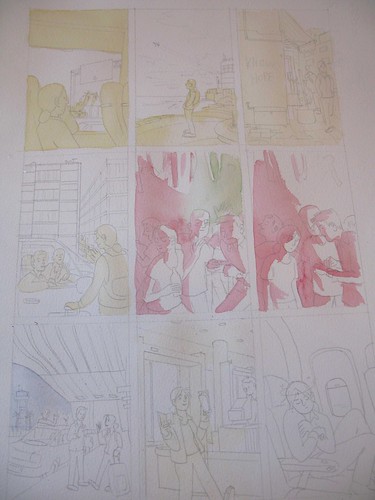Hey Matt,
I've recently read the Scott Pilgrim comics and become interested in drawing comics. I've always been a hopeless drawer though so i got a book to teach me some basics and it's really helping so far, but it doesn't teach anything about comics. I found your blog very useful but its hard to find somewhere to begin. Are there any books out there you'd recommend to teach basic comic drawing?
Josh.
Short answer:
Scott McCloud's Understanding Comics
Scott McCloud's Making Comics
Jessica Abel and Matt Madden's Drawing Words and Writing Pictures
David Chelsea's Perspective! For Comic Book Artists
Read those and do all the assignments suggested in them, and you'll have just saved yourself 4 years of college. I wish I were more than a hair away from kidding.
Long answer:
To get good at comics you'll have to read a lot of comics, and learn to steal. I don't mean imitate- that's like stealing someone's jewelry by hoisting their house into the back of your pickup and driving off. It doesn't work and you look like a moron doing it. You must learn to steal- and I use that word deliberately- the very best parts of what works about your favorite artists, and throw away the rest. You must learn to avoid taking on the bad habits of artists you like, the way you might avoid contracting AIDS. It's so easy, SO easy, to look at a great artist, imitate (meaning copy totally) their art, including it's weak parts, and then defend those weaknesses for decades as the inspiration you got from a great artist, instead of a cheap, hacky trick that both you and the artist you got it from should be shamed of. Jack Kirby was insanely inventive and kinetic and used blacks like no human being before or since, but he basically drew humans with 2 not very good faces and just slightly more expressions. Dave Sim has an incredible work ethic and is a proficient inker and letterer, but his people are ugly, stiff, and insensitive. Moebius and Frank Quitely are some of the best draughtsmen on the planet, but they draw distracting and freakish baby faces on everyone and sometimes their art can be lifelessly static.
Everyone's style is a combination of all the things they're best at, and attempts to either avoid or cover the evidence of everything they suck at. Mike Mignola once confessed to a class I was in that he doesn't draw cars because he hates drawing them and uses lots of shadows because he sucks at perspective. You'll eventually form your style by lazily covering up all the things you suck at; don't add to that all the things your favorite artists suck at.
This counts ten thousand times more if your art is Manga influenced. Every single one of my manga influenced artist friends will back me on this: if you take your cues by imitating your favorite manga, you will spend years of your commercially crippled career painfully stripping your art of the shortcuts that, by sheer necessity of how fast those artists must produce, makes up 1/2 to fully 9/10ths of the art of any given page of manga.
If you ever find yourself thinking "Oh, finally, this art looks like something I can actually draw!", put the book down and never look at it again. If bikes are hard for you, fill a sketchbook with people on every kind of bike you can find reference for. If hands are really tricky for you, never, ever draw a panel without showing both hands of every person in the panel. If shoes are tricky for you, don't do another damned thing until you can draw everything from sneakers to dress shoes convincingly. Learn to draw brick walls that don't look like cinderblock walls. Read a lot of good comics, look at a lot of good art, read a lot of good books, and learn to steal the very best from all of them. And don't imitate.
And now, some links for this week!
Andrew Loomis made the best art instruction books for illustrators and cartoonists ever made, and you can download them in their entirety, for free, online!
For young or beginning artists who want a warm, earnest, supportive place to get input on their work, there's few places better than the Flight Forums. Professionals from the books and others who just hang out are always watching to give advice to all those who seek it.
Why has Alec Longstreth given up on rapidographs and pigma pens? Find out!
Listen to Dean Haspiel.
Remember how I was talking about absorbing the worst shortcuts from people's work? Here's a great example. Ha, "Dreamworks brow."
Next week, another eraser showdown!










